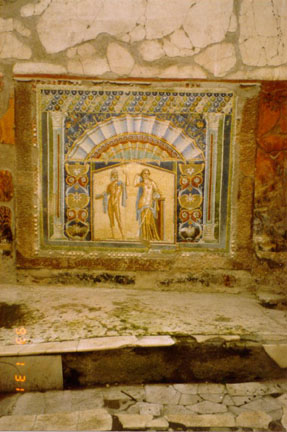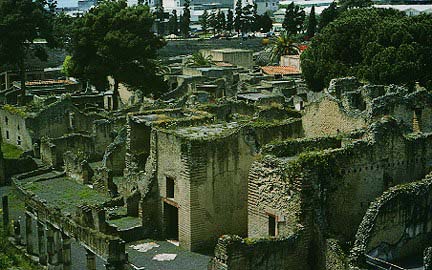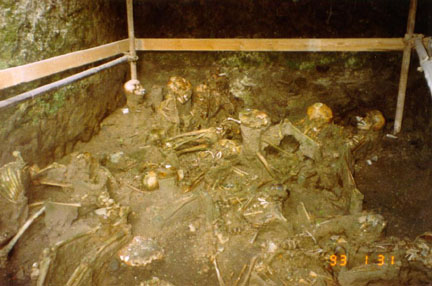Many of the world's great volcanoes, such as Vesuvius, Fujiyama, Egmont, and many others, are strato-volcanoes, with both lava flows and pyroclastic deposits
(http://www.deakin.edu.au/~agoodman/scc205/volcano/ollier.html)

Vesuvio Volcano, Italy
"Volcano number: 0101-02= (according to Volcanoes of the World, 1994 edition)
Summit elevation: 1281 m
Location: 40.821°N, 14.426°E" (www.geo.mtu.edu/~boris/VESUVIO.html)
"The rocks at Vesuvius are called tephrite. A tephrite is basaltic in character and contains the following minerals: calcic plagioclase, augite, and nepheline or leucite".(http://volcano.und.nodak.edu/vwdocs/volc_images/img_vesuvius.html). Vesuvius is above a subduction zone. The African plate is moving northward at about one inch per year and is slowly closing the Mediterranean basin. As it moves to the north, the African plate is pushed beneath the Eurasian plate.

(http://www.arttoday.com)
"Vesuvio
(Vesuvius) is probably the most famous volcano on Earth, and
certainly
one of the most, if not the most dangerous. It is also notable for
having
produced the first eruption of which an eyewitness account is
preserved,
in AD 79. Geologically, Vesuvio is particular for its unusual
versatility,
its activity ranging from Hawaiian style emission of very
liquid
lava, fountaining, and lava lakes, over Strombolian and Vulcanian
activity
to violently explosive, Plinian events that produce pyroclastic
flows
and surges." (www.geo.mtu.edu/~boris/VESUVIO.html)
See this
picture and more by clicking here.
Aftermath of the eruption:
The
eruption of Mt. Vesuvius in A.D. 79 (which was described by
Pliny
the Younger) buried Pompeii, along with Herculaneum and Stabiae, under
cinders
and ashes that preserved the ruins of the city with magnificent
completenessódown
to the fresh colors of the wall paintings.

(http://volcano.und.nodak.edu/vwdocs/volc_images/europe_west_asia/vesuvius_more/vesuvius_more.html)
Pompeii
was a flourishing port city, as well as a prosperous resort spot with many
villas
for the more wealthy Roman citizens. The long forgotten site of the city
was rediscovered in 1748 and has been
sporadically
excavated since that time. The habits and manners of life in
Roman
times have been revealed in great detail at Pompeii by the plan of the
streets
and footpaths, the statue decorated public buildings, and the simple
shops
and homes of the artisans. The houses and villas have yielded rare and
beautiful
examples of Roman art.
Here is a picture of the ruins left perfectly intact by the destructive volcanic ash and lava:

(http://volcano.und.nodak.edu/vwdocs/volc_images/img_vesuvius.html)
As
the explosion continued, Pompeii, as well as the nearby cities of Herculaneum
and Stabiae, are covered in a pyroclastic flood of cinders, ash, and mud
around 20 feet high. The eruption of Mt. Vesuvius covered the city of Pompeii
leaving eerie statues of the community. The foolish who choose to
remain behind are trapped in this flood and preserved for centuries until
the city was re-discovered in 1748. Approximately 20,000 people were
killed in this eruption.
The
day of doom, described by Pliny the younger, a Roman soldier who sailed
into the port of Stabiae to try to help some of the people
fleeing the volcano:
"Now
the day begins, with a still hesitant and almost lazy dawn. All
around
us buildings are shaken. We are in the open, but it is only a
small
area and we are afraid, nay certain, that there will be a
collapse.
We decided to leave the town finally; a dazed crowd follows
us,
preferring our plan to their own (this is what passes for wisdom in
a
panic). Their numbers are so large that they slow our departure,
and
then
sweep us along. We stopped once we had left the buildings behind
us.
Many strange things happened to us there, and we had much to fear."(Radice,
B., 1968, The Letters of Younger Pliny: New York, Penguin. )
Below is a picture of a dog that was killed and preserved by the massive eruption:

The following is a picture of a group of people who ran for shelter in a boathouse. Notice how some of the people seem to be hugging each other:

(http://volcano.und.nodak.edu/vwdocs/volc_images/europe_west_asia/vesuvius_more/vesuvius_more.html)
The
following is a list of known Mt. Vesuvius eruptions:
The
eruptions before A.D. 79
The
3750 BP "Avellino" eruption
The
A.D. 79 eruption
Eruptions
from A.D. 79 until 1631
The
AD 472 "Pollena" eruption
The
AD 512 eruption
The
1631 eruption
The
1631-1944 eruptive cycle
Eruptive
activity, 1632-1794
There
are no signs of volcanic unrest at Vesuvius at the present time (February
1996).
Eruptive
activity of Vesuvio obviously occurs in cycles that last several
centuries
and alternate with repose periods lasting several centuries as
well.
Each of these repose periods ends with a major (Plinian) eruption,
thus
initiating an active cycle